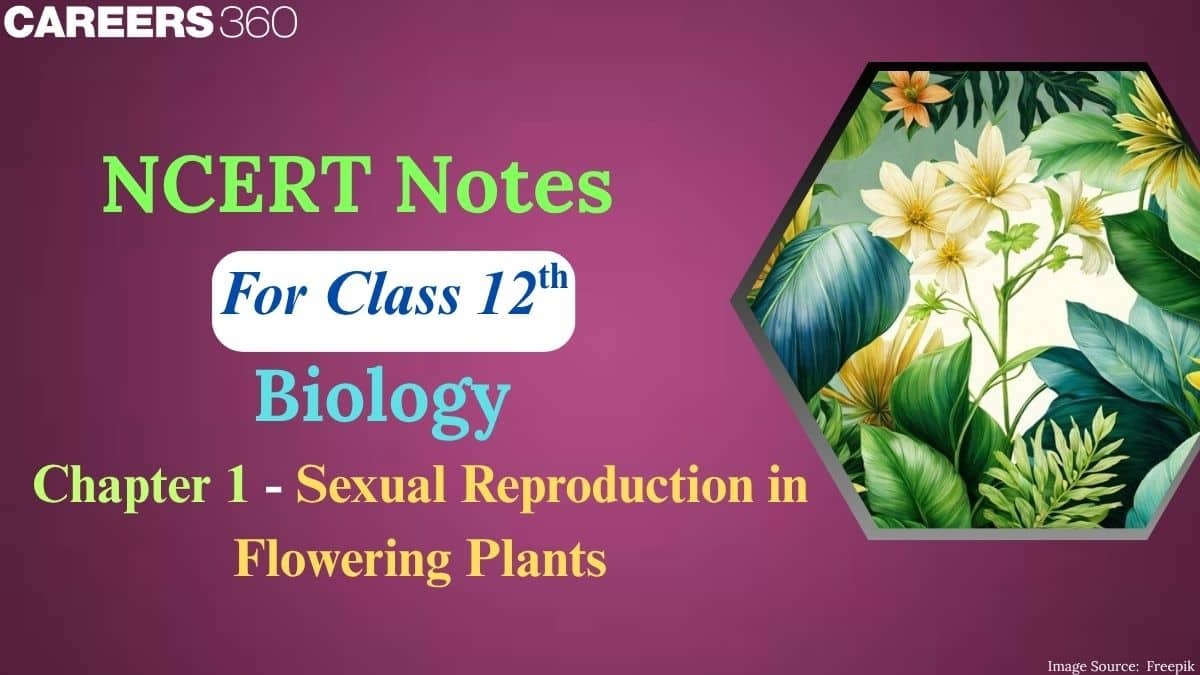Class 12 Biology Chapter 1 Sexual Reproduction in Flowering Plants Notes
The notes on Sexual Reproduction in Flowering Plants simplify the chapter by breaking down the difficult processes into easy steps. They explain topics like post-fertilisation events, including the development of seeds and fruits, and special phenomena like apomixis and polyembryony. The chapter highlights how these processes ensure species continuity and how seeds mature to give rise to new plants. The Sexual Reproduction in Flowering Plants Class 12 Notes use short and clear points and include all the topics of NCERT, so students can revise quickly without missing anything.
What is Reproduction?
Reproduction is the process that ensures the continuity of species generation after generation, as the older individuals undergo aging and die. In the case of flowering plants, they show the sexual mode of reproduction and bear complex male and female reproductive units along with accessory structures.
The flower is a modified stem that functions as a reproductive organ and produces ovum/pollen. A typical angiosperm flower consists of four whorls of floral appendages attached to the receptacle, that is:
Calyx
Corolla
Androecium (male reproductive organ consisting of stamens)
Gynoecium (composed of the ovary, style, and stigma).
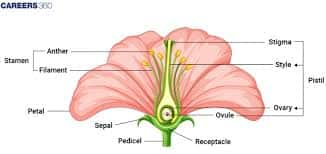
Pre-fertilisation (Structures and Events)
Before fertilisation, several hormonal and structural changes are initiated, which lead to the differentiation and further lead to the development of the floral primordium, and then inflorescences are formed, which bear the floral buds and then the flowers.
Stamen:
It consists of a long and slender stalk called a filament and generally bilobed anthers. Each lobe contains two thecae (dioecious).
Anther:
It is a four-sided structure consisting of four microsporangia, two in each lobe.
Microsporangia:
It develops further and becomes pollen sacs that contain pollen grains.
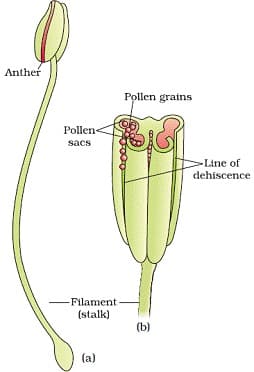
Microsporangium
It is generally surrounded by four-layered walls:
Epidermis
Endothecium
Middle layer
Tapetum.
The innermost layer of the tapetum provides nourishment to the developing pollen grains.
Microsporogenesis:
The process of the formation and differentiation of microspores (pollen grains) from microspore mother cells (MMC) by reductional division is called microsporogenesis. Sporogenous tissues are those that are compactly arranged in the form of homogenous cells, and they are present at the center of each microsporangium when the anther is young.
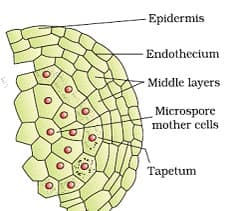
Pollen grains
It represents the male gametophytes nd made up of two-layered walls that are,
Exine- It is made up of sporopollenin, and it is the most resistant organic matter known. It can withstand high temperatures, strong acids, and alkali, and it can degrade sporopollenin.
Intine- Thin and continuous layer. Made of cellulose and pectin
Germ pore
It apertures on the exine where sporopollenin is absent and forms the pollen tube. A plasma membrane surrounds the cytoplasm of the pollen grain, and a mature pollen consists of 2 cells with a nucleus (Vegetative and Generative)
Vegetative cell:
Generative Cells:
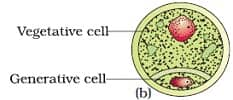
Allergies to pollen grains
For example, Parthenium causes severe types of allergies and bronchial/lung diseases in some people and leads to chronic respiratory disorders– asthma, bronchitis, etc.
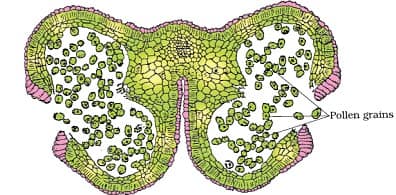
Pollen grains are very rich in nutrients, and they are also used as pollen tablets as food supplements.
The viability of pollen grains varies from species to species, and they should land on the stigma before this period to germinate. Pollen grains of a large number of species are stored in liquid nitrogen at a temperature of – 196 °C, called a pollen bank.
The Pistil, Megasporangium, and Embryo Sac
- Gynoecium may consist of a single pistil (monocarpellary) or more than one pistil (polycarpellary), which may be fused (syncarpous) or free (apocarpous). For example:
-Multicarpellary and syncarpous pistil- Papaver
-Multicarpellary and apocarpous pistil- Michelia
Each pistil has three parts:
Inside the ovary is the ovarian cavity, locule, and the placenta is located inside the ovarian cavity. Whereas megasporangia (ovules) arise from the placenta.
Megasporangium
The ovule is a small structure attached to the placenta.
Hilum- the junction between the ovule and the funicle
Integuments- protective envelopes
Micropyle- a small opening at the tip of the ovule through which the pollen tube enters
Chalaza- basal part of the ovule
Nucellus (2n)-mass of cells enclosed in integuments. Has an abundant food reserve.
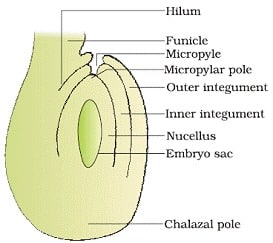
Megasporogenesis
The process of formation of a megaspore from a megaspore mother cell by meiotic division is known as megasporogenesis. This process takes place in the ovule.
Ovule differentiates a single megaspore mother cell (MMC) in the micropylar region of the nucellus. MMC undergoes meiosis that results in the production of four megaspores.
• Remember that in most of the flowering plants, a total of three megaspores degenerate. One megaspore develops into a female gametophyte that is an embryo sac.
• The nucleus of a functional megaspore divides mitotically to form two nuclei, which move to opposite poles to form a 2-nucleate embryo sac. Two more sequential mitotic divisions result in the 8-nucleate embryo sac.
• Six of the eight nuclei are surrounded by a cell wall, and the remaining two nuclei (polar nuclei) are situated below the egg apparatus.
• Three cells are grouped at the micropylar end to constitute the egg apparatus, and three cells at the chalazal end form antipodal cells. At maturity, the embryo sac is 8-nucleate and 7-celled.
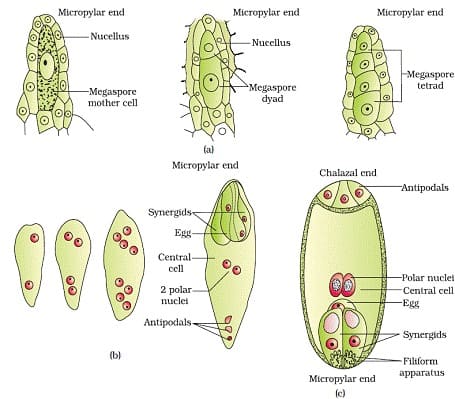
Pollination
Transfer of pollen grains from the anther to the stigma is referred to as pollination.
a) Autogamy
Transfer of pollen grain from the anther to the stigma of the same flower.
I. Cleistogamous– flowers that do not open. Cleistogamous flowers are autogamous, as there is no chance of cross-pollen landing on the stigma. Cleistogamous flowers produce assured seed-set even in the absence of pollinators. e.g., Viola (common pansy), Oxalis, and Commelina.
ll. Chasmogamous– exposed anther and stigma.
b) Geitonogamy:
Transfer of pollen grains from the anther to the stigma of a different flower of the same plant. Geitonogamy is functionally cross-pollination involving a pollinating agent; genetically, it is similar to autogamy since the pollen grains come from the same plant
c) Xenogamy:
Transfer of pollen grain from anther to the stigma of different plants’ flowers of the same species.
Agents of pollination include abiotic (water, wind) and biotic (insects, butterflies, honey bees, etc.). A large number of pollen grains are produced by plants using the abiotic mode of pollination, as most of the pollen grains are wasted during transfer.
Adaptations in Flowers for Pollination
1. Wind Pollination
pollen grains: light, non-sticky, winged
Anther: well exposed
stigma: large and feathery
flower: one ovule, arranged as an inflorescence
Ex: corn cob, cotton, date palm
2. Water Pollination
Bryophytes, Pteridophytes, Algae
Ex: Freshwater plants- Vallisneria, Hydrilla
Seagrass- Zostera
Main features of wind and water-pollinated plants
– produce pollen grains in large no.
– do not produce nectar
3. Insect Pollination
– Flowers: large, colorful, fragrant, rich in nectar
– Pollen grains: sticky
– Stigma: sticky
Benefits to pollinators:
Ex: Amorphophallus, Yucca
Outbreeding Devices
The various mechanisms discourage self-pollination and encourage cross-pollination, as continued self-pollination leads to inbreeding depression. It includes:
• Pollen release and stigma receptivity are not synchronized.
• Anthers and stigma are placed at a different position.
• Inhibiting pollen germination in the pistil.
• Production of unisexual flowers.
Pollen pistil interaction
The pistil can recognize the compatible pollen to initiate post-pollination events that lead to fertilisation. A pollen grain produces a pollen tube through germ pores to facilitate the transfer of male gametes to the embryo sac.
Artificial Hybridization
Crossing of different varieties/species to obtain hybrids with desirable traits is known as artificial hybridization.
- Emasculation: Removal of anthers in bisexual flowers.
- Bagging: Covering emasculated flowers to prevent unwanted pollination.
Double Fertilisation
This event takes place when two types of fertilisation take place; after entering one of the synergids, each pollen grain releases two male gametes, and then one male gametes fuse with the egg (Syngamy), and the other male gametes fuse with two polar nuclei (triple fusion) to produce a triploid primary endosperm nucleus (PEN).
So, when two types of fusion take place in an embryo sac, the phenomenon is called double fertilisation. The PEN develops into the endosperm, and the zygote develops into the embryo.
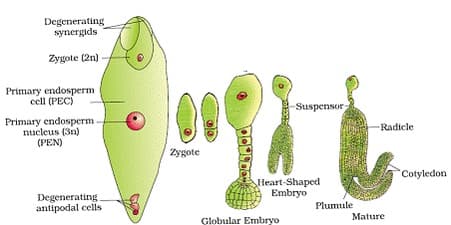
Post-Fertilisation Events
Post-fertilization events include endosperm and embryo development, maturation of ovules into seeds, and the ovary into fruits.
Endosperm
A primary endosperm cell divides many times to form triploid endosperm tissue, having reserve food materials.
Two types of endosperm development :
Free nuclear type
Cellular type
Non-albuminous seeds: Endosperm used up (e.g., pea, groundnut).
Albuminous seeds: Endosperm persists (e.g., wheat, maize, castor).
Embryo Development
Embryo development takes place at the micropylar end.
Stages: Proembryo → Globular → Heart-shaped → Mature embryo.
An embryo consists of the embryonal axis, cotyledons, plumule, and radicle.
Seed and Fruit Formation
Apomixis and Polyembryony
Apomixis: Asexual reproduction mimicking the sexual process, seed without fertilisation (e.g., Citrus, Mango).
Polyembryony: More than one embryo in a seed is known as polyembryony (e.g., Citrus, Groundnut).
Also, Read
Sexual Reproduction in Flowering Plants: Previous Year Question and Answers
Some of the questions that have come in past years from the chapter are given below. By referring to the Sexual Reproduction in Flowering Plants Class 12 Notes, students can understand how reproduction takes place in flowers.
Question 1. The generative cell was destroyed by a laser, but a normal pollen tube was still formed because
Option 1. The vegetative cell is not damaged
Option 2. Contents of killed generative cells stimulate pollen growth
Option 3. The laser beam stimulates the growth of the pollen tube
Option 4. The region of emergence of the pollen tube is not harmed
Answer :
Pollen grain or microspore divides mitotically, forming a larger tube or vegetative cell and a small generative cell. Since vegetative cells give rise to pollen tubes and the generative cell divides to form two male gametes, if a generative cell is destroyed by a laser, a normal pollen tube will still form through the vegetative cell, which is undestroyed.
Hence, the correct answer is option (1). The vegetative cell is not damaged
Question 2. During embryo germination in a grass family, an absorptive organ that forms an interface between the embryo and the starchy endosperm tissue is called
Option 1. Coleorhiza
Option 2. Coleoptile
Option 3. Scutellum
Option 4. Mesocotyl
Answer :
The scutellum is a specialized cotyledon in monocot seeds, especially in grasses, that absorbs nutrients from the starchy endosperm and transfers them to the growing embryo during germination. It acts as an interface between the endosperm and the embryo, ensuring proper nourishment for seedling development.
Hence, the correct answer is option (3), Scutellum
Question 3. What would be the number of chromosomes in the cells of the aleurone layer in a plant species with 8 chromosomes in its synergids?
Option 1. 24
Option 2. 32
Option 3. 8
Option 4. 16
Answer :
Consider that the taxon species comes under the taxon genus. A genus is an aggregate of related species that are similar to each other in many correlated characteristics. The genus can be monotypic, i.e., having one species or polytypic, i.e., having many species. Genus Solanum possesses species like Solanum nigrum, Solanum tuberosum (potato), Solanum melongena (brinjal), etc.
Hence, the correct answer is option (1), 24
Question 4. In angiosperms, double fertilisation occurs because
Option 1. Two pollen grains take part
Option 2. Two male gametes fertilise two eggs
Option 3. One male gamete fuses with the egg and the other with the polar nuclei
Option 4. Synergids fuse with male gametes
Answer :
In angiosperms, one male gamete fuses with the egg to form the zygote, while the other male gamete fuses with the two polar nuclei to form the primary endosperm nucleus. This unique process is called double fertilisation.
Hence, the correct answer is option (3), One male gamete fuses with egg and the other with polar nuclei.
Question 5. Which part of the flower develops into the seed coat after fertilisation?
Option 1. Ovary wall
Option 2. Ovule integuments
Option 3. Nucellus
Option 4. Endosperm
Answer :
After fertilisation, the integuments of the ovule harden and form the seed coat. The seed coat protects the developing embryo from mechanical injury and desiccation.
Hence, the correct answer is option (2), Ovule integuments.
Also Read:
